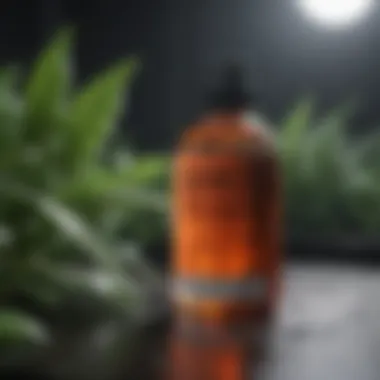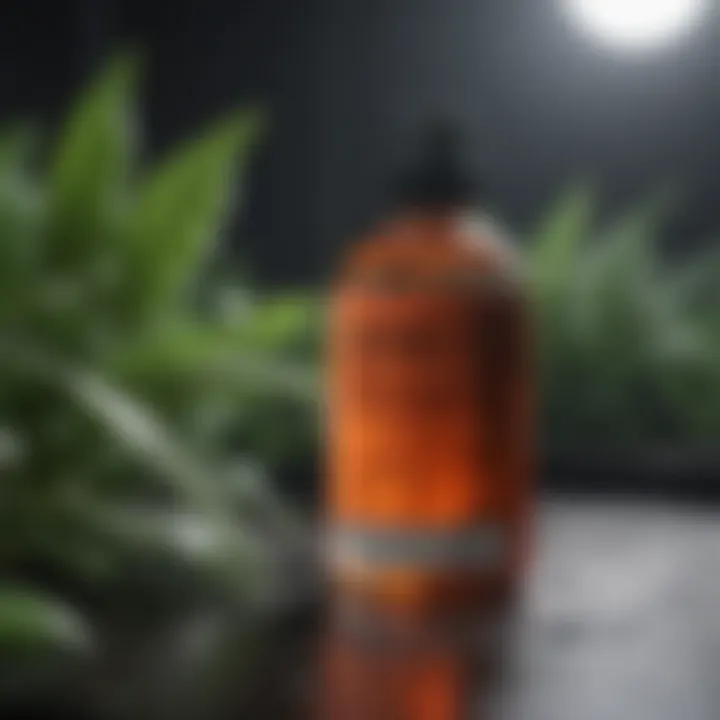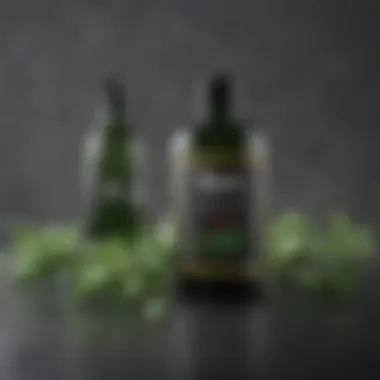Understanding Dithane M45 Fungicide: A Detailed Review


Intro
In the world of agriculture, crop protection is of utmost importance to ensure healthy plants and sustainable harvests. Among the various tools at farmers' disposal, fungicides play a critical role in safeguarding crops from damaging diseases. One such notable fungicide is Dithane M45, renowned for its effectiveness against a range of fungal infections that can hinder plant growth. With a rich chemical composition and specific application methods, understanding Dithane M45 is crucial for agronomists, researchers, and practitioners engaged in crop management.
This article aims to dissect the many facets of Dithane M45, from its chemical underpinnings to its broader implications in agricultural practices. We’re going to touch on everything from its mechanism of action to the regulations that govern its use on crops. The objective here is not merely to present data, but to foster a deeper understanding of how this fungicide functions and the context in which it is applied.
Key Concepts and Terminology
Understanding Dithane M45 requires familiarity with some essential terms and concepts that will be discussed throughout the article.
Definition of Key Terms
- Fungicide: A chemical used to kill or inhibit the growth of fungi, which are responsible for various plant diseases.
- Active Ingredient: The component of the fungicide responsible for its biological effect. In Dithane M45, the key active ingredient is Mancozeb.
- Resistance Management: Strategies aimed at delaying or preventing the development of resistance among pest populations.
Concepts Explored in the Article
- Chemical Composition: A look into the specific structures that make Dithane M45 effective against fungi.
- Application Methods: Different techniques for applying this fungicide to maximize its benefits while minimizing risks.
- Environmental Impact: An analysis of how Dithane M45 interacts with the ecosystem, focusing on safety for non-target organisms.
- Regulatory Framework: Understanding the legal landscape surrounding the use of Dithane M45 in agriculture, including registration and safety protocols.
- Integrated Pest Management (IPM): How Dithane M45 fits into broader strategies for managing pests and diseases in sustainable agriculture.
Findings and Discussion
Main Findings
Dithane M45 has proven exceptionally effective in numerous field trials. Farmers using this fungicide have reported substantial improvements in crop yield and quality.
- Efficacy: Dithane M45 works by disrupting the cellular respiration of fungi, effectively preventing infection before it can establish.
- Broad-Spectrum Activity: Its ability to tackle different fungal pathogens makes it versatile for a variety of crops, ranging from vegetables to fruits.
- Safety Measures: Precautions are emphasized to protect both applicators and beneficial organisms in the vicinity.
"Dithane M45 stands out not just for its effectiveness but also requires careful management in application to avoid any unintended ecological consequences."
Potential Areas for Future Research
While Dithane M45 has been a stalwart in agricultural practices, challenges remain that warrant further exploration:
- Resistance Management: Research is needed to develop strategies that prevent resistance to Dithane M45 among fungal pathogens.
- Long-term Environmental Studies: Investigating the long-term effects of Dithane M45 on soil microorganisms and surrounding ecosystems will be crucial to ensuring sustainable practices.
- Synergistic Effects: Further studies could explore how Dithane M45 interacts with other pesticides in integrated pest management strategies to increase efficacy.
In summary, Dithane M45 offers a valuable tool for combating plant diseases, but it is essential for practitioners to stay informed about its uses, implications, and the ongoing research surrounding its application.
Intro to Dithane M45
Dithane M45 is a name that resonates in the realm of agricultural practices, particularly for those involved in plant health management. This fungicide plays a pivotal role in controlling a multitude of plant diseases, making it an invaluable tool for farmers and agronomists. Its significance cannot be overstated, especially when one considers the ongoing battle against fungal pathogens that threaten crop yields and food security. With the right applications, Dithane M45 helps ensure that crops can thrive even in challenging conditions.
Historical Background and Development
Dithane, as a product, has roots that dig deep into agricultural history. Initially launched in the mid-20th century, it arose from the need to safeguard crops against devastating fungal diseases that had the potential to wipe out entire harvests. Its development was driven by the agricultural sector's ambitions to maximize yields and improve food production efficiency.
Since its inception, Dithane M45 has undergone numerous formulations and research efforts, aimed at increasing its effectiveness while minimizing environmental impacts. Over the years, various studies have documented its success against specific pathogens, solidifying its position as a go-to for many agronomists. The flexible nature of Dithane M45 allows it to be utilized across a range of crops, appealing to both large-scale farmers and niche agricultural operations.
Chemical Structure and Composition
The success of Dithane M45 can largely be attributed to its unique chemical composition. This fungicide primarily contains mancozeb, a compound known for its broad-spectrum coverage against various fungal threats. The active ingredients in Dithane M45 work by interfering with the cellular respiration of fungi, effectively hindering their growth and proliferation.
To delve deeper into its structure, mancozeb is classified as a dithiocarbamate, featuring a distinctive [(chemical) structure that is crucial to its function]. The effective formulation not only allows for an impact on the immediate fungal threats but also offers residual action, providing ongoing protection to treated plants. Further, its compatibility with other products in the field adds another layer of versatility, allowing farmers to integrate it seamlessly into their existing pest management regimes.
In summary, understanding the historical context and the chemical makeup of Dithane M45 equips stakeholders in agriculture with the knowledge necessary to make informed decisions. Whether enhancing plant resilience or addressing pest pressures, its role is paramount.
Mechanism of Action
Understanding the mechanism of action of Dithane M45 is crucial for anyone involved in agricultural practices, whether one is an academic, a student of plant sciences, or a practitioner in the field. In essence, this section elucidates how this fungicide effectively combats plant diseases, which is imperative for developing efficient disease management strategies in crops.
Fungicidal Properties
Dithane M45 predominantly operates through contact action. Its active ingredient, mancozeb, targets fungal pathogens on the surface of plants, preventing their growth and reproduction. Unlike systemic fungicides, which are absorbed and translocated within plants, Dithane M45 remains on the exterior, effectively forming a protective barrier against disease.
One of its standout features is its broad-spectrum activity. It combats various fungi, including those causing leaf spots, blights, and downy mildews. The fungicide employs multiple modes of action, which not only enhances its efficacy but also mitigates the risk of resistance development among targeted pathogens.
Key Points about Fungicidal Properties:


- Speed of Action: Dithane M45 starts working shortly after application, making it highly effective in preventing disease outbreaks.
- Residual Activity: Provides extended protection against infections, ensuring crops remain healthy for longer periods.
- Protection Against Rain Wash-off: Its robust adherence to plant surfaces means that rain cannot easily wash it away, which is critical in maintaining effective protection under variable weather conditions.
This combination of attributes underscores Dithane M45's significance in integrated pest management (IPM) strategies. By using it effectively, farmers can experience increased crop yields and better overall plant health, reinforcing the product's value in the agricultural sector.
Impact on Fungal Cells
The impact of Dithane M45 on fungal cells lies in its ability to disrupt cellular functions. When fungal spores land on treated plant surfaces, the fungicide acts by inhibiting several critical physiological processes within the fungi.
Primarily, Dithane M45 affects the synthesis of proteins necessary for fungal growth and reproduction. This interference can lead to disruption of cell division, ultimately causing the death of fungal cells. Additionally, the fungicide compromises the integrity of fungal membranes, further obstructing their ability to thrive.
This kind of cellular disruption is pivotal. By halting the development of fungal colonies, Dithane M45 not only treats existing infections but also prevents potential future outbreaks. Its effectiveness is particularly pronounced in environments prone to high humidity, where fungal diseases are more likely to proliferate.
"By not allowing fungal pathogens a chance to establish their foothold, Dithane M45 plays a critical role in maintaining crop health."
One practical aspect of understanding impacts on fungal cells is in the timing and method of application. When applied proactively, especially during periods favorable to fungal growth, Dithane M45 can significantly reduce disease incidence in crops.
Applications in Agriculture
The role of Dithane M45 in agriculture cannot be overstated. This fungicide has carved out a significant niche for itself, particularly in the realm of crop protection. Its application directly correlates with plant health and yields, making it a vital tool in any agricultural setting. Understanding how it integrates into farming practices is crucial for maximizing its impact and ensuring sustainability.
Types of Crops Treated
Dithane M45 is versatile when it comes to the types of crops it treats. Farmers have embraced this fungicide due to its effectiveness against numerous diseases that can impair plant growth. Here are some key crops that benefit significantly from Dithane M45:
- Fruit Crops: This includes popular varieties such as grapes, apples, and strawberries. These fruits often face fungal threats like powdery mildew and brown rot, making Dithane M45 an indispensable ally.
- Vegetable Crops: Notably, crops like tomatoes, cucumbers, and peppers can be prone to diseases, which can lead to substantial losses. The fungicide protects these vegetables against various fungal pathogens, thus ensuring healthy produce.
- Ornamental Plants: Many growers of ornamental flowers and plants also utilize Dithane M45 to maintain the aesthetics and health of their products against diseases like leaf blight and rust.
- Field Crops: It also finds its use in larger-scale farming with crops such as corn and wheat, helping to prevent diseases that could devastate entire fields.
Each of these crops thrives under careful management of fungal diseases, and the application of Dithane M45 contributes to a noticeable enhancement in overall crop resilience.
Recommended Application Techniques
To harness the full potential of Dithane M45, applying it correctly is key. Here are some recommended techniques:
- Timing of Application: The ideal window for applying this fungicide generally falls just before or at the onset of disease pressure. Early intervention can significantly mitigate the likelihood of outbreaks.
- Application Methods: Farmers can utilize several methods while applying Dithane M45. Commonly used techniques include:
- Mixing with Other Pesticides: Dithane M45 can often be compatible with other agrochemicals, giving farmers flexibility in their treatment regimens. However, it is essential to consult the product label to avoid negative interactions that could reduce effectiveness.
- Environmental Considerations: Applying the fungicide during calm weather conditions is advisable to minimize drift and enhance absorption. Wet conditions can also help maximize efficacy, but too much rain right after application can wash the product off.
- Foliar Spraying: This method ensures the fungicide covers the plant surface effectively, delivering direct action against pathogens. It’s essential to achieve even coverage to avoid missed spots.
- Soil Application: In some cases, Dithane M45 can be incorporated into the soil, allowing plants to absorb the fungicide systemically. This can be particularly beneficial for root diseases.
The application of Dithane M45, when executed with precision, can yield remarkable improvements in crop health and productivity. Be sure to keep abreast of best practices and local guidelines to ensure optimal outcomes in your agricultural pursuits.
Effective crop management hinges on timing and technique, especially when deploying fungicidal solutions like Dithane M45.
By integrating these practices, farmers can leverage Dithane M45 to its fullest potential, safeguarding their crops against a myriad of fungal adversities. This ensures not only better yields but also plays a pivotal role in maintaining the ecological balance within agricultural settings.
Advantages of Using Dithane M45
Dithane M45 has carved out a substantial niche in the agricultural landscape, primarily due to its impressive benefits. Understanding these advantages is paramount for those involved in agricultural applications and pest management strategies. Not only does it offer a robust solution to combat specific plant pathogens, but it also boasts compatibility with various agrochemicals that can enhance overall crop health and yield.
Efficacy Against Specific Pathogens
One of the most compelling reasons for the use of Dithane M45 is its proven efficacy against a variety of pathogens. It works well against notorious fungal threats such as Phytophthora, Botrytis, and Alternaria. Each of these can wreak havoc on crops, leading to significant losses if not managed effectively.
The reason for its effectiveness lies in its mode of action. Dithane M45 disrupts the cellular processes of fungi, stopping them in their tracks. When applied correctly, it can provide protection over an extended period, reducing the frequency of applications necessary and thereby saving time and resources for farmers and growers. This fungicide is particularly advantageous for crops that are prone to repeated fungal infections, ensuring that healthy, productive plants can thrive.
"The dual action of prevention and treatment makes Dithane M45 a popular choice among agronomists and farmers alike."
Compatibility with Other Agrochemicals
Another significant advantage of Dithane M45 is its compatibility with other agrochemicals. This feature opens up avenues for integrated pest management practices, where farmers can combine multiple products for a more effective strategy against pest and disease pressures. For instance, it can be employed alongside insecticides and fertilizers, creating a comprehensive approach to crop management.
The blend of Dithane M45 with other agrochemicals must be approached judiciously. Farmers are advised to conduct small-scale tests to ascertain the effectiveness of combinations and to follow guidelines set forth by product labels to avoid any adverse interactions. This compatibility aids in the development of tailored solutions that cater specifically to a grower's unique agricultural needs.
In summary, the advantages of using Dithane M45 extend beyond mere efficacy against fungal pathogens. Its compatibility with a variety of other agrochemicals embodies a holistic approach to modern agriculture, providing both effectiveness and versatility that can be leveraged for optimal crop performance.
Safety Considerations
When handling any agricultural chemical, safety is paramount. With Dithane M45 being a widely used fungicide, understanding its safety protocols becomes essential for farmers and agricultural professionals. Effective application of safety measures not only ensures the well-being of individuals but also protects the environment and maximizes efficacy during usage.
Handling and Application Precautions


Before applying Dithane M45, users should adhere to certain handling guidelines to minimize risks:
- Use Personal Protective Equipment (PPE): Always wear suitable gloves, masks, and eye protection to avoid dermal and respiratory exposure.
- Read the Label Carefully: The product label holds critical information regarding dosage, application methods, and specific precautions. Ignoring these instructions can lead to undesirable outcomes.
- Storage Conditions: Dithane M45 should be stored in a cool, dry place, away from children and pets. Ensure the container is tightly sealed to prevent leaks and contamination.
- Emergency Procedures: Familiarize yourself with first aid measures in case of accidental exposure. Knowledge of how to respond can lessen the severity of any incident.
Working in accordance with these precautions significantly reduces risks associated with the product. Therefore, practitioners must consistently apply these practices to create a safe working environment.
Toxicological Data and Risks
Understanding the toxicological aspects of Dithane M45 provides a clearer picture of its safety profile:
- Acute Toxicity: While Dithane M45 is generally regarded as safe when used correctly, it’s not without risks. Signs of acute toxicity include headaches, nausea, and dermatological reactions, which can occur in instances of improper handling.
- Chronic Effects: Prolonged exposure may lead to more serious health issues, such as respiratory problems or skin sensitization. Regular monitoring and adherence to safety guidelines can help mitigate these risks.
- Environmental Toxicity: It’s not just human safety that we must consider; Dithane M45 has implications for non-target organisms. Data shows its potential impact on bees and aquatic environments, necessitating careful application to avoid unintended harm.
"Safety precautions should never be an afterthought; they are the backbone of responsible pest management practices."
In summary, while Dithane M45 serves a vital role in agricultural health, its effective and safe application relies on strict adherence to safety practices. Both the users and the ecosystems they operate within greatly benefit from these precautions. By understanding and respecting the toxicological data associated with this fungicide, users can ensure that they are safeguarding not just their own health, but the health of the environment as well.
Environmental Impact
Understanding the environmental impact of Dithane M45 is paramount in the ongoing dialogue about sustainable agricultural practices. As the world grapples with the dual challenges of increasing food production and preserving ecosystem integrity, assessing the implications of using chemical fungicides becomes increasingly critical. Dithane M45, while effective against a broad spectrum of plant pathogens, warrants a thorough examination to ensure that its use aligns with environmental sustainability.
Effect on Non-Target Organisms
The interaction between Dithane M45 and non-target organisms is a vital consideration for its use in agriculture. Non-target organisms include beneficial insects, such as pollinators and natural predators of pests, along with soil microorganisms that play essential roles in nutrient cycling and soil fertility.
Research indicates that Dithane M45 has a relatively low toxicity to many beneficial organisms when used according to the prescribed guidelines. However, it is essential to bear in mind:
- Species Sensitivity: Different species exhibit varying levels of sensitivity. While some beneficial insects may prove resilient, others can experience adverse effects.
- Application Timing: Executing applications during periods when beneficial insects are not active can mitigate potential negative impacts.
- Dilution and Formulation: The specific formulation used can affect toxicity levels. Ensuring that farmers are aware of these factors can help protect vital non-target organisms.
"Considering the broader ecological web is essential when implementing any pest control measure; Dithane M45 is no different."
Soil and Water Implications
The implications of Dithane M45 on soil and water systems are significant. The compound's behavior in these environments must be understood to prevent potential contamination and adverse effects.
- Soil Health: Dithane M45's active ingredient, mancozeb, can affect soil microbial communities. These microorganisms are crucial for organic matter breakdown and nutrient availability. A disruption in their population could lead to altered soil health, affecting crop yields in the long run.
- Water Contamination: The risk of runoff during heavy rains can transport residues into nearby water bodies, leading to contamination. This scenario raises concerns not just for aquatic organisms but also for drinking water quality. Monitoring and management techniques should be adopted rigorously to minimize such risks.
- Regenerative Practices: Integrating practices such as cover cropping and buffer zones can help protect soil and water resources from the effects of Dithane M45, making its usage more sustainable.
Each agronomic decision involving Dithane M45 must weigh its benefits against its environmental impacts. A clear understanding of these implications is essential for responsible agricultural management and to safeguard ecological health.
Regulatory Perspective
Understanding the regulatory landscape surrounding Dithane M45 is crucial for both practitioners and researchers in agriculture. Regulations help ensure that not only is the product effective in managing plant diseases, but it is also safe for human health, animal life, and the surrounding environment. The importance of regulatory oversight cannot be overstated. It ensures that each application meets rigorous safety and environmental standards, ultimately fostering trust among consumers and agricultural professionals alike.
Approval Status in Various Regions
The approval status of Dithane M45 varies significantly across different geographical regions, reflecting the diverse agricultural practices and regulatory frameworks in place. In the United States, the Environmental Protection Agency (EPA) has evaluated Dithane M45 for its effectiveness and safety. It gained registration thanks to supportive data proving it poses minimal risk when used according to its guidelines.
- In Europe, it is categorized within the framework of EU regulation on pesticides. Member states may approve its use based on local assessments, sometimes adding extra restrictions. For instance, Dithane M45 has seen varying acceptance among countries like Germany and France, where stringent ecotoxicological assessments are required.
- Meanwhile, in developing nations, Dithane M45's acceptance may hinge more on existing pest challenges and economic viability, as regulations in these regions can sometimes lag behind those in more developed agricultural markets.
Notably, ongoing discussions about sustainable practices often impact approval processes, where ecological concerns are weighed against agricultural necessities.
Labeling and Usage Guidelines
Labeling and usage guidelines for Dithane M45 serve as vital documents for applicators. They provide detailed instructions on safe handling, recommended dosages, and application frequency. Following these guidelines is nonnegotiable for ensuring the fungicide's effectiveness while safeguarding health and the environment.
For instance, the label typically contains the following key elements:
- Target Diseases: Specific diseases that Dithane M45 can combat, aiding users in targeting their strategies appropriately.
- Application Rates: Precise dosages to maximize efficacy and minimize risks of resistance in fungal populations.
- Re-entry Intervals: Required times after application that must pass before human or animal re-entry into treated areas, ensuring safety.
- Environmental Precautions: Advisories on preventing runoff and protecting non-target species, emphasizing responsible stewardship.
In summary, comprehending regulatory perspectives, including approval status and labeling, ensures that Dithane M45 is used effectively and responsibly, safeguarding agronomists, consumers, and the delicate balance of our ecosystems.
Proper regulation means not just compliance, but a shared commitment to responsible agriculture.
For more information on regulatory standards, you may visit Wikipedia or refer to discussions on Reddit regarding current trends and concerns in pest management regulations.
Integrated Pest Management
Integrated Pest Management (IPM) is a cornerstone of modern agricultural practices, combining a variety of strategies to control pests and diseases effectively while minimizing the negative impact on the environment. The importance of IPM in this context cannot be overstated. It cultivates a holistic approach to agriculture that is sustainable and resilient. Instead of relying solely on chemical interventions, an integrated approach incorporates biological, cultural, physical, and sometimes chemical means to manage pests, providing a more balanced ecosystem for crops.


Key benefits of implementing IPM include:
- Reduction in Pesticide Use: By combining various control methods, farmers can often use fewer chemicals like Dithane M45, thus reducing the risk of developing pest resistance.
- Economic Savings: A well-structured IPM program can lead to lower costs in pest management over time because it minimizes reliance on expensive chemical treatments.
- Environmental Protection: Through careful planning and monitoring, IPM strategies lessen the impact on non-target organisms and the broader ecosystem.
- Enhanced Crop Health: By managing the pest populations and fostering biodiversity, crops tend to show improved resilience against diseases and pests over time.
A successful IPM program involves regular monitoring, risk assessment, and the selection of appropriate control measures tailored to specific pest issues, which brings us to the role of Dithane M45 in this framework.
Role of Dithane M45 in IPM
Dithane M45 has established itself as a significant player in Integrated Pest Management. Its fungicidal properties specifically target various fungal diseases affecting crops, making it a valuable tool for farmers looking to implement IPM strategies. Here are a few aspects of its role in IPM:
- Pest Control Spectrum: Dithane M45 is effective against a wide range of pathogens such as downy mildews and leaf spots. Integrating it into an IPM framework allows for timely treatment and disease prevention, thereby reducing crop losses.
- Compatibility with Biological Controls: This fungicide can complement biological pest control methods. For instance, when used alongside beneficial fungi or microbial agents, it enhances overall disease suppression while safeguarding non-target species.
- Resistance Management: Given the potential for pathogens to develop resistance, Dithane M45 can be strategically rotated with other fungicides. This practice not only prolongs its effectiveness but also reinforces the overarching objectives of IPM—keeping the disease pressure at bay without fostering resistance.
Alternatives and Resistance Management
While Dithane M45 is a powerful tool within IPM, it is crucial to consider alternative strategies and resistance management techniques as pivotal elements of an effective pest management plan.
Some alternatives to consider are:
- Cultural Practices: Practices such as crop rotation, intercropping, and selecting resistant crop varieties can naturally reduce pest populations. These methods serve as preventive measures that complement chemical applications.
- Biological Control Agents: Introducing natural predators or pathogens can help maintain pest populations at manageable levels without relying solely on chemicals. This approach not only aids in disease management but also encourages a more diverse ecosystem.
- Physical Barriers: Using nets or mulches can physically deter pests from affecting crops, providing a non-chemical approach that aligns with IPM principles.
For resistance management, it’s essential to:
- Monitor and Assess Resistance: Regularly testing pathogen populations for signs of resistance can inform management strategies and determine the need for changing control tactics.
- Rotate Modes of Action: Using fungicides that act through different mechanisms helps in avoiding the selection pressure that leads to resistance, thus ensuring Dithane M45 remains effective.
Future Directions in Research
The focus on the future directions in research regarding Dithane M45 is crucial for several reasons. First and foremost, continuous research is vital to adapt to emerging challenges in agriculture, such as increased fungal resistance towards fungicides. This growing concern directly affects crop health and yields, making it imperative that scientists and agriculturalists understand how to counteract resistance and maintain effectiveness in pest control.
Another aspect to consider is the agility of agricultural practices in response to climate change. Research studies can help in fine-tuning application rates and timing based on local climatic conditions. Furthermore, innovations can enhance the efficiency and sustainability of using Dithane M45 without compromising environmental safety.
Addressing Resistance Challenges
Resistance is an uphill battle in the agricultural landscape. As fungi evolve, they begin to evade the effects of established fungicides, including Dithane M45. If we want to tackle this challenge effectively, ongoing research must aim to understand the mechanisms behind this resistance. Knowledge gained can drive the development of integrated management strategies that combine chemical applications with cultural and biological controls. For instance:
- Identifying resistant fungal strains can help in developing targeted treatments.
- Utilizing crop rotation and diversity can minimize resistance development among pest populations.
- Implementing field trials helps establish protocols on how to rotate fungicides.
It’s not just about maintaining efficacy; it’s also about optimizing Dithane M45's performance and potentially avoiding complete reliance on specific chemical solutions.
Innovations in Application Technology
When it comes to using Dithane M45, precision and efficacy go hand in hand. There's a buzz around innovations that enhance how fungicides are applied. New technologies such as drone-assisted spraying and smart irrigation systems allow for more targeted applications, reducing waste and minimizing ecological impact.
Moreover, advancements in formulation technology can lead to products with improved adhesion and longevity on plant surfaces. Such improvements could include:
- Development of slow-release formulations that can prolong protection.
- Utilizing nanoscale technologies to create better encapsulation, ensuring the active ingredient reaches its target effectively.
The future looks promising with these innovations that not only refine the application but also enhance the overall utility of Dithane M45 in sustainable pest management strategies.
Research is the key to adapting Dithane M45 in an ever-evolving agricultural environment.
In summary, pursuing research in these areas could yield impactful improvements in pest management strategies, ensuring that Dithane M45 remains a valuable asset in the agricultural toolkit.
End
Bringing together the threads of our discourse on Dithane M45, it's clear that this fungicide stands as an essential tool in modern agriculture. Its significance lies not only in its powerful action against a variety of fungal diseases but also in how it integrates into broader pest management strategies. The understanding of Dithane M45 is vital for anyone engaged in agriculture, as it offers a blend of effectiveness, operational convenience, and regulatory compliance that many other products may lack.
Summary of Key Points
As we recap the documents highlighted in this examination, several key points stand out:
- Chemical Composition: Dithane M45 is based on mancozeb, which helps in effectively managing plant diseases while having notable properties for safety and environmental stability.
- Mechanism of Action: The fungicidal properties primarily inhibit fungal growth by affecting cellular functions. This leads to reduced disease incidence in crops.
- Applications: Widely used across various crops, Dithane M45’s versatility makes it a prominent choice for farmers. Application methods also align well with existing agricultural practices, reducing disruption and fostering more successful outcomes.
- Advantages: It poses minimal harm to beneficial insects and has low toxicity for mammals, making it a safer option compared to alternatives. Its compatibility with other agrochemicals further extends its utility in integrated pest management frameworks.
- Environmental and Safety Concerns: Aware of the environmental implications, regulators have set detailed guidelines governing its use. Familiarity with these regulations is prudent for sustainable agricultural practices.
- Future Directions: Ongoing research is addressing resistance challenges, ensuring that Dithane M45 remains effective amidst evolving fungal threats. Moreover, innovations in application technology pave the way for improved efficiency and precision.
In summary, the composite of knowledge surrounding Dithane M45 is not just about understanding its chemical makeup or its agricultural applications. It underscores the responsibility that comes with usage in the face of environmental considerations and the need for sustainable practices.
Final Thoughts on Dithane M45
In the larger context of agricultural sustainability and productivity, Dithane M45 serves as more than just a fungicide. It embodies a bridge between effective crop protection and environmentally conscious farming practices. While understanding its potential advantages, it is also imperative to navigate the limitations and risks associated with reliance on it as a single solution. The synergy between Dithane M45 and integrated pest management protocols is a topic worth further exploration.
In the end, as the agricultural landscape evolves, innovation, research, and adaptability will dictate the path forward. These factors, combined with the insights gained from this examination of Dithane M45, will empower farmers and agronomists in making more informed decisions.
"Knowledge gained today will bear fruit tomorrow; it is through understanding and foresight that we shape the future of agriculture."
Keeping an eye on the ongoing research and trends in fungicide management, alongside adhering to safety and regulatory commitments, remains crucial for anyone involved in the cultivation process. Staying abreast of these developments will not only enhance the effectiveness of Dithane M45 but ensure its role in sustainable agricultural practices for years to come.







